2.1 Overview of the Entrepreneurial Journey
Learning Objectives
By the end of this section, you will be able to:
- Explain the entrepreneurial journey to explore and discover entrepreneurship as a career choice
- Identify the steps, decisions, and actions involved in the entrepreneurial journey
- Recognize the rewards and risks of the steps in the entrepreneurial journey
Self-Employment as an Entrepreneurial Journey
When the economy and the job market are strong, the entrepreneur has a safety net that decreases the risks in creating a new venture, a startup company or organization that conducts business or is created to satisfy a need, and allows for a quick recovery if the venture is not successful. There are more new startups when there are high levels of confidence in both the venture’s success and the entrepreneur’s confidence in finding employment if the venture fails. People over 40 years of age account for most new startup activity, in part because of the continuing trend in which a business may choose not to hire an employee but instead hire an independent contractor, a person who provides work similar to an employee without being part of the payroll for the contracting business, and who is responsible for paying their own taxes and providing their own benefits. With previous knowledge and expertise, this group of entrepreneurs recognizes opportunities created by this move away from hiring full-time employees to more outsourcing to independent contractors.
One contributor is the gig economy, which involves using temporary and often transitional positions hired on a case-by-case basis, rather than keeping a full staff of hired employees. Advantages for the employer include a decrease in cost of benefits and loyalties to specific employees. Advantages for the hired worker or independent contractor (sometimes called a freelancer) include no long-term commitment and flexibility in accepting contracts. From an entrepreneurial perspective, the creation of websites that support the gig economy offers opportunities for independent ventures. Many people today are becoming small entrepreneurs. This process goes by a variety of names, such as the sharing economy, the gig economy, the peer economy, or the collaborative economy. Maybe it means driving for a company such as Lyft, Uber, or GrubHub, or perhaps offering services through TaskRabbit, UpWork, or LivePerson.
The projected numbers of independent contractors and on-demand workers are stated as 42 percent for small businesses by the year 2020, a growth of 8 percent from current figures.[1] And a projection of greater than 50 percent of the workforce will be independent contractors by 2027 if this trend continues at the current pace.[2] In the “Freelancing in America: 2019” report, the sixth annual study by UpWork and Freelancers Union, 57 million United States citizens are estimated to freelance, with income approaching 5 percent of US gross domestic product (GDP) at nearly $1 trillion and earning a median rate of $28.00 an hour, representing an hourly income greater than 70 percent of workers in the overall US economy.[3] One report found that 94 percent of net job growth from 2005 to 2015 was in alternative work categories, with 60 percent due to independent contractors and contract company workers.[4]
According to the US Bureau of Labor Statistics, the number of self-employed Americans is growing, with 9.6 million self-employed people at the end of 2016. That number is expected to grow to 10.3 million by 2026.[5] A more recent study by FreshBooks’ second annual “Self-Employment” report predicts that 27 million US employees will leave traditional work in favor of self-employment by 2020, tripling the current population of full-time self-employed professionals to 42 million. The main driver for this change in the workforce is a greater desire for control over one’s career with the ability to have greater control over working hours and acceptance of work.[6][7]
Of course, self-employment is a broad category that includes small-business owners as well as entrepreneurial startups and freelance gig employees. Since 2016, there has been a downward slide in the number of employees working for self-employed businesses, which results from a variety of factors, including difficulties in finding qualified employees, qualified employees having more employment options, such as employment through the gig economy, outsourcing activities, and technology actions that decrease the need for employees, with entrepreneurial activity remaining steady.[8]
Entrepreneurship around the World
In a 2017 Business Insider article, “America Needs Immigrant Entrepreneurs,” David Jolley writes that immigrants constitute 15 percent of the US workforce and 25 percent of the country’s workforce of entrepreneurs.[9] Forty percent of startups include at least one immigrant. Jolley’s article cites a study that identified immigrants as twice as likely to start a business as people born in the United States. In 2016, 40.2 percent of Fortune 500 companies were founded by at least one immigrant or a child of immigrant parents. Dinah Brin, writing for Forbes, stated in a 2018 article that immigrants form 25 percent of new US businesses and that new immigrant-owned firms generated 4 to 5 million jobs.[10]
These statistics and other findings have prompted countries such as Canada to revise their immigration policies to attract more entrepreneurial-minded immigrants. A World Bank report from May 2018 ranked the United States 53rd out of 190 countries for ease in starting a business, with higher scores representing greater ease.[11] The same report ranks the United States eighth for ease of doing business. The difference in these rankings indicates that once a business is established, factors such as regulations, permits, access to credit, and infrastructure support the business owner’s ability to continue the business, but actually starting the business is more challenging. For any given country, ease in starting a business and the country’s interest in supporting entrepreneurial activity are crucial in both attracting entrepreneurial people and supporting their ability to open a business. Imposing restrictive regulations and processes on new ventures significantly decreases the number of new ventures.
According to a 2018/2019 report, the highest rate of entrepreneurial activity worldwide in 2018 was in Angola at 41 percent.[12] Angola’s low-income economy meant fewer employment opportunities, creating pressures to find other ways to earn an income. Guatemala and Chile reported 28 percent and 25 percent of entrepreneurial activity, respectively, with medium- and high-income economies. These percentages are quite high, considering that these economies offer employment opportunities in existing companies. In terms of innovation, India at 47 percent, and Luxembourg and Chile at 48 percent each, take the lead in offering new products and services not previously available. This entrepreneurial activity reflects the ease of starting a business. The Netherlands, Poland, and Sweden were reported as the easiest countries in which to start a new business, in part because many people in those countries view entrepreneurship as an attractive lifestyle. As you can see, both economic opportunities and a country’s specific support for entrepreneurial behavior contribute to the number of people who enter entrepreneurial activities.
From a gender perspective, there are currently over 11 million woman-owned businesses in the United States. This number includes both small business owners and entrepreneurs. Thirty years ago, there were only 4 million woman-owned businesses.[13] The number of woman-owned businesses has increased 45 percent between 2007 and 2016, five times faster than the national average, with 78 percent of new women-owned businesses started by women of color.
Starting Your Entrepreneurial Journey
How do you fit into this entrepreneurial journey? This chapter will help you to explore and discover your potential for entrepreneurship as a career choice. Think of this exploration and discovery experience as a way to map out a strategy to reach your goals or dreams. Let’s imagine that your dream vacation is a hiking trip to Glacier National Park in the US state of Montana. Just as hikers have different levels of experience, so do entrepreneurs. Just as your plan for a wilderness hike would involve many stages, your entrepreneurial journey involves multiple levels of self-discovery, exploration, experiences, and accomplishments on your way to success. For our purposes, the term entrepreneurial venture means any type of new business, organization, project, or operation of interest that includes a level of risk in acting on an opportunity that has not previously been established. For each story of entrepreneurial success that is shared—such as that of Facebook or Airbnb—there are even more lesser-known entrepreneurial success stories such as Zipline, a company that delivers medical supplies in Rwanda and Ghana by drone. These entrepreneurs faced the same dilemmas in pursuing their passion, or opportunities, which led them to their entrepreneurial destiny. They courageously stepped out of their comfort zones to explore the possibilities that lie ahead. What is the difference between entrepreneurs and you? The main difference is taking that first step. Many people have ideas that fit into the definition of an entrepreneurial idea but never take that first step. Just as the Chinese philosopher Lao Tzu suggests, every journey begins with a single step.
Exercise – Taking the First Step
Go to Fire Nation’s website on taking the first step to learn more. Changing your mindset (your perception of yourself and your life situation) and encountering trigger events (significant external situations) can nudge you into taking the first step toward being an entrepreneur.
- Is there a venture you’ve always thought you should start but never did?
- Think about what factors are stopping you. Consider your mindset and how you might change your mindset so that your venture could become a reality.
- What are some possible trigger events that could make the difference between starting your venture and waiting to start your venture?
Opening your future to the possibility of starting your own venture brings new and exciting experiences (Figure 2.2). Every entrepreneur moves through several steps in considering the entrepreneurial journey. Once you understand this journey, the steps will help you define your path toward creating and starting your new venture. Each step of this process offers another level of understanding that prepares you for long-term success. How will you achieve this success? By taking one step at a time, exploring and learning, considering new ideas and expectations, and applying these experiences to achieve your personal outcome. Think of the entrepreneurial journey as a guide to knowing what is in store for you as you start your new venture.
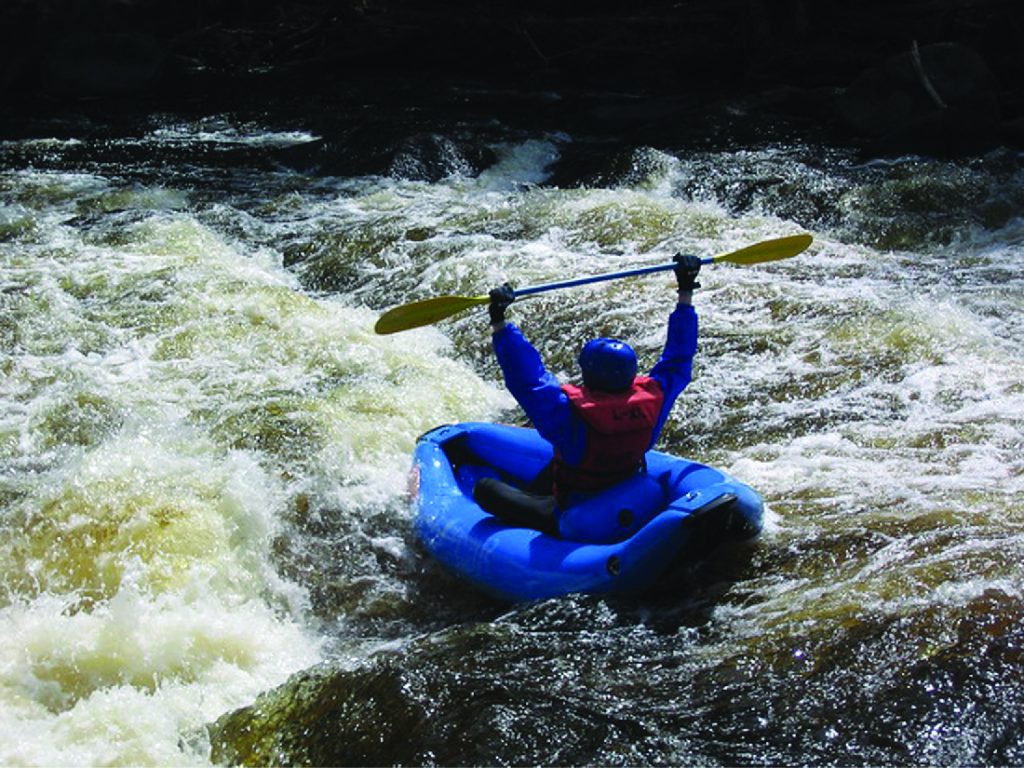
One benefit of outlining a step-by-step process is the opportunity to explore different paths or behaviors that may lead to an entrepreneurial venture. Think again of your dream visit to Glacier National Park. How would you get there? What equipment would you need? What kinds of experiences would you expect to have? Think of the Glacier National Park journey as your entrepreneurial journey, a metaphor intended to help you as you create your career as an entrepreneur.
What makes someone ready or willing to choose entrepreneurship over becoming an employee of an established business or a small business owner? It takes confidence, courage, determination, resilience, and some know-how to select entrepreneurship as a career as well as the recognition of the opportunity. An entrepreneur is defined as someone who not only recognizes an opportunity but who also is willing to act on that opportunity. Both actions are required. We might identify an opportunity, but many people do not act on the idea. Confidence, courage, and willingness are necessary to take that first step, as well as remembering the following:
You are unique. Even if two similar people attempted to launch identical ventures, the results would likely not be the same. This is because each one of us has different ideas, approaches, available resources, and comfort levels, all of which influence the venture’s development and eventual success.
Although there are no hard and fast rules or theories of the best way to launch into entrepreneurship, we can gain wisdom from the lessons learned by experienced entrepreneurs.
Selecting an entrepreneurial career requires honesty, reflection, and a tendency to be action oriented. You will need to recognize your own strengths, limitations, and commitment as part of that honesty. Reflection is required for self-growth—seeking improvements in your own skills, interactions, and decision making—and commitment is required to maintain consistency in your willingness to make the new venture a top priority in your life. You will also need to understand that you cannot accomplish everything by yourself, and you may need to ask for help. It helps to be curious, open, and able to take calculated risks and to be resourceful and resilient when faced with challenges or obstacles.
Exercise – Entrepreneurial Potential Self-Assessment
Take this quick Entrepreneurial Potential Self-Assessment to assess your potential to become an entrepreneur. After completing this self-assessment, what new information did you learn about yourself? Do you think your answers will change as you acquire more life experiences and education? Why or why not?
Exercise – Optimizing Interest Areas
- What are three areas that interest you? These could be hobbies, work activities, or entertainment activities.
- How would someone else describe your skills and interests, or what you are known for?
Answering these questions provides insights into your strengths and interests.
- Next, what is one area that you are passionate about?
- What strengths could you bring to this passion to build your own business?
Keep an open mind in looking for an opportunity that fits your strengths and interests.
- If you decide to explore entrepreneurship, what would be your first step?
- What are your initial thoughts about being an entrepreneur?
- What would you review or search to find more information on your idea or area of interest?
- With whom would you first question or discuss this idea? Why?
The Entrepreneurial Journey as a Trip
The entrepreneurial journey is your exploration to discover if entrepreneurship is right for you. Every entrepreneurial journey is unique; no two individuals will experience it in the same way. Along the way, you will find opportunities and risks coupled with challenges and rewards. It’s useful to think about the entrepreneurial journey as an exciting trip or other adventure. Most of the preparations and steps involved with planning a trip are like those for starting a venture. Just as you would plan and prepare for a trip—starting with inspiration and leading up to finally traveling on the trip—you might follow similar steps to launch a venture. And just as you would prepare for any challenges that you might encounter on a trip—bad weather, lost luggage, or detours—so you should consider potential obstacles or barriers along your entrepreneurial journey (Figure 2.3). Think of these difficulties as opportunities to learn more about the entrepreneurial process—and about yourself and how you manage challenges.

Developing a venture can be an exciting and active experience. It is also a lot of hard work, which can be equally rewarding and enjoyable. Here we present the entrepreneurial journey as seven specific steps, or experiences, which you will encounter along the road to becoming an entrepreneur. You’ll find more information about the entrepreneurial journey in other chapters in this book.
- Step 1: Inspiration – What is your motivation for becoming an entrepreneur?
- Step 2: Preparation – Do you have what it takes to be an entrepreneur?
- Step 3: Assessment – What is the idea you plan to offer through your venture?
- Step 4: Exploring Resources – What resources and characteristics do you need to make this venture work?
- Step 5: Business Plan – What type of business structure and business model will your venture have?
- Step 6: Navigation – In what direction will you take your venture? Where will you go for guidance?
- Step 7: Launch – When and how will you launch your venture?
As you work through each step of the entrepreneurial journey you should prepare for significant aspects of this experience. You will meet with rewards and challenges, the consequences that result from the decisions made at various points along your journey. To visualize the steps of the entrepreneurial journey, imagine your possible hiking trip to Glacier National Park (Table 2.1). Just as hikers have different levels of experience, so do entrepreneurs. Compare the following aspects of preparing for a hike with aspects of your entrepreneurial journey.
Hiking and Entrepreneurial Journey Metaphor
| Type of Hiker | Mountain Hiking Skill Level | Entrepreneurial Journey Equivalent |
|---|---|---|
| Walker | Basic or limited hiking experience | New or limited entrepreneurial exposure Never started a venture |
| Climber | Moderate hiking experience Special skills for adventure, difficult terrain |
Some entrepreneurial knowledge or experience Exposure to entrepreneurship (family or friend in business) |
| Mountaineer | Experienced hiker with technical skills for climbing hills and mountains | Experienced entrepreneur Attempted or launched a venture (solo or with partner) |
Step 1: Inspiration
When you think of being an entrepreneur, what is the inspiration for your venture? Just as you might have an inspiration for a hiking trip to Glacier National Park, you will have an inspiration behind the decision to become an entrepreneur. When you’re planning a trip to a new and exciting place, one thing you might do is to imagine what you will experience along the journey and on arriving at your destination (Figure 2.4). This portion of the entrepreneurial journey includes imagining yourself as an entrepreneur or as part of an entrepreneurial team. For this stage, you need a creative, open, and innovative state of mind, also known as an entrepreneurial mindset, which is discussed in more detail in The Entrepreneurial Mindset and Creativity, Innovation, and Invention. Dream big about your potential future and opportunities (Figure 2.5).


Step 2: Preparation
Just as when you are preparing for a trip, you need a plan (Figure 2.6) to move forward on your entrepreneurial journey. Before your dream hiking trip, you might gather information about Glacier National Park from a trusted source, such as a good friend with travel experience, or you might conduct online research. Your friend’s feedback could be just the motivation you need to try this experience yourself. Or you might use your research to determine if the trip is possible. You will need to look at maps, either online or on paper. Either way, you might also consider travel and accommodation options, such as booking a flight and finding a place to stay. You might want to create benchmarks to align your journey with your available resources, such as the amount of time and the amount of money you have to spend on the trip. Benchmarking is a method of tracking target expectations with actionable results by comparing one’s own company’s performance with an industry average, a leader within the industry, or a market segment. Benchmarking can help design the trip to meet incremental goals and timelines. From both a travel plan and an entrepreneurial perspective, although benchmarking is used as a control mechanism, we know that situations can arise that require an alteration in the plan, causing the benchmarked items to also need adjustments.
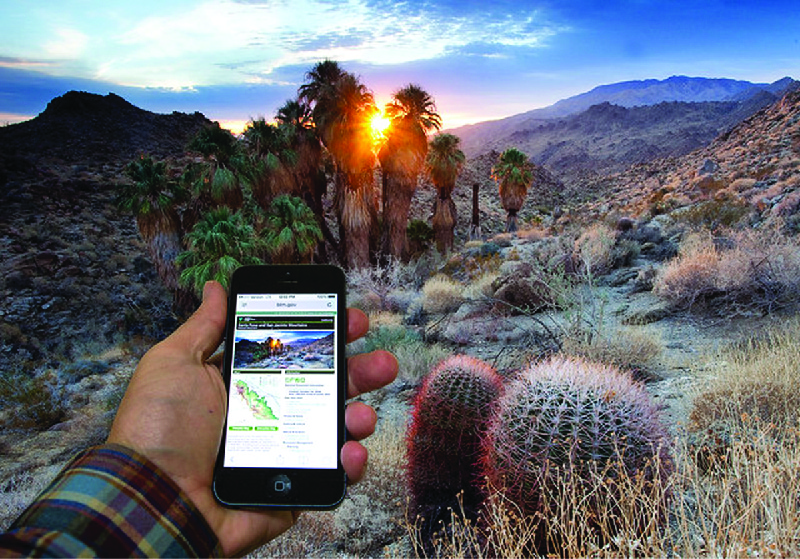
Link to Learning
Which type of benchmarking will help you the most in beginning your entrepreneurial journey? Visit the American Society for Quality’s resource page on benchmarking for help.
To plan for an entrepreneurial journey, you should first conduct some preliminary research regarding your venture idea. Your research must be honest and objective if it is to give you a clear picture of the venture. Next, you might organize and prioritize your research and thoughts. For instance, you might see an idea like yours online or on television, and feel disappointed that someone stole your great idea or beat you to the punch. This is a common occurrence in entrepreneurship, but it should not discourage you. Instead, use that knowledge and energy to find an overlooked or different aspect of your original idea. The difference might even be the focus on a different target market, a specific group of consumers for whom you envision developing a product or service. Further, it is critical to maintain a fluid focus upon expanding the scope of a product or service to uniquely differentiate provisions of benefits apart from existing benefits or those offered by competitors. A focus on a different target market is exactly how the Jitterbug smartphone was created, because it targeted senior citizens. The Jitterbug smartphone offers a larger screen, larger buttons, and simpler features that make it easier for older people to make quick calls or send texts.
Preparation also includes opening space in your life to the time and energy commitment needed to support your new venture. Are the important people in your life willing to support the interest and passion you will need to dedicate the time, energy, and other resources to this new venture? Review the questions shown in (Figure 2.7) to consider your answers to these questions.
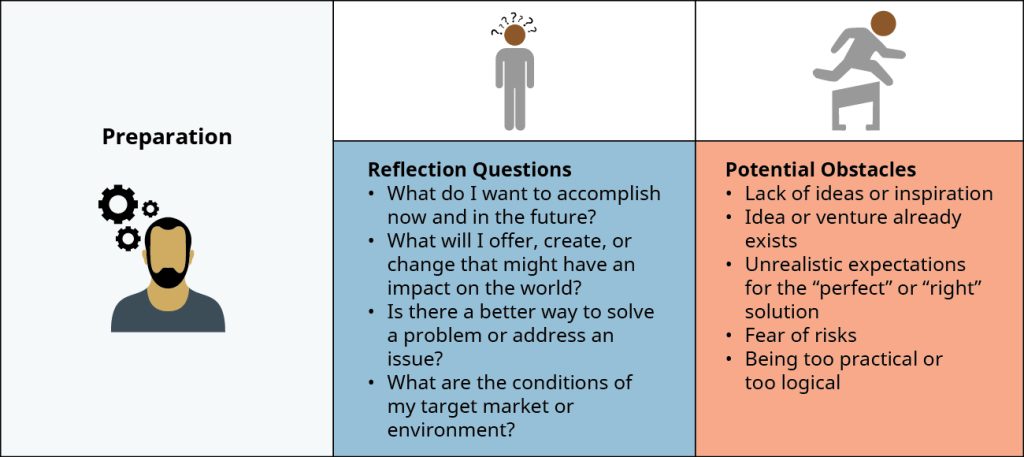
Step 3: Assessment
Now that you have decided where to go for your trip and have gathered information to prepare for it, the next action is to create and set your schedule. This action is simple but critical, because it involves connecting and coordinating information and resources that fit your lifestyle and needs. For example, you might schedule an early-morning Uber or Lyft to the airport and electronic delivery of your plane tickets to your smartphone. For the entrepreneurial journey, this phase might also include recognizing appropriate relationships and gathering needed resources. For many entrepreneurs, the opportunity to receive guidance from trusted advisors or mentors may provide valuable insights on how to manage the process. This step allows for reflection on your idea and intentions. After you’ve done your researching and gathering knowledge about your idea through the preparation step, is the idea still viable? Is the idea still interesting to you? With a better understanding of the industry, your idea, and your own interests that you gained in Step 2, is this idea something that you still want to explore?
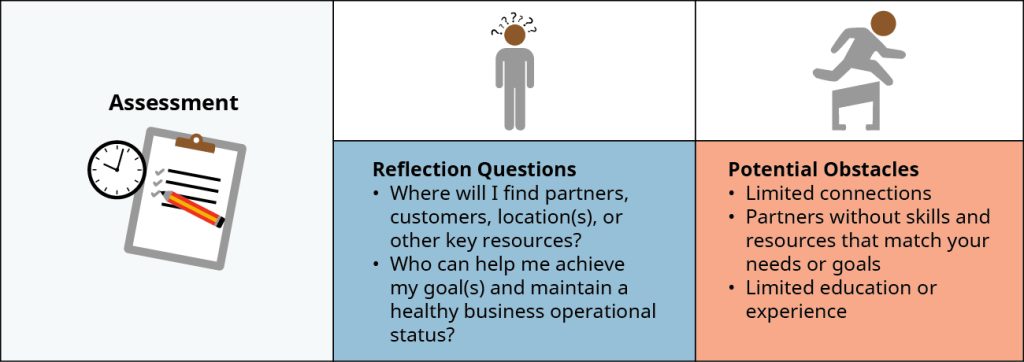
Step 4: Exploring Resources
Regardless of where you might travel, you could not complete your trip without adequate resources such as available financing. There are many ways you might fund a hiking trip: savings, loan, pay-as-you-go, sponsorship (family or friends), or any combination of these options, to name a few. No matter how you finance your trip, it might help to have a balance of available credit and cash on hand to support your day-to-day expenses and any extracurricular activities or even unforeseen emergencies. As discussed in Entrepreneurial Finance and Accounting, the US Small Business Administration (SBA) provides funding opportunities.
This scenario is mirrored in the entrepreneurial journey. Just as you wouldn’t begin a trip without adequate resources, including access to cash, you wouldn’t begin your entrepreneurial journey without the necessary resources, including cash. The options between funding a trip and funding a new venture are similar, but they have different names. For example, on a trip, you might use the cash you have on hand, from savings or a personal loan. For an entrepreneurial journey, you might address cash management—management of cash inflows and outflows to support cash needs of the venture—to include bootstrapping, a funding strategy that seeks to optimize use of personal funds and other creative strategies (such as bartering) to minimize cash outflows. (See Entrepreneurial Finance and Accounting for more information on bootstrapping.) Bootstrapping includes ideas like leasing instead of purchasing, borrowing resources, or trading unneeded resources for needed ones. Another example of cash management includes a business model that offers subscriptions rather than a payment received for an item purchased. Subscriptions provide the entrepreneur with cash up front, with the buyer receiving benefits throughout the year. Consider the example of Amazon. Amazon offers Prime with a yearly subscription service, as well as Subscribe & Save, Amazon Instant Video, Amazon Mom, and Amazon Web Services, all based on a subscription business model.
According to Entrepreneur.com, other potential subscription-based models include services or products geared to older consumers, with 8,000 people turning sixty-five every day. A similar idea offers services to college students. Both ideas would offer family members a subscription that sends monthly gifts or products to either the elderly person or college student. We also see this model offered to pet owners who pay a monthly subscription to receive treats and toys for the family dog. Looking back at Amazon, we see the company offering the ease of repeat purchases for frequently used products such as vitamins and air filters.
Entrepreneur In Action
Prospurly
Prospurly is a subscription-based company that uses Cratejoy’s subscription platform to sell small-batch artisanal products for bath, body, and home, marketing a natural lifestyle focused on the happiness of living a simple and appreciated life. Conduct your own research on Prospurly and other subscription-based businesses. Read the article, “How I Built a Subscription Business That’s Made over 50k in 6 Months,” on Cratejoy for more information about this company and Prospurly’s move from ideation to profitability.
Other ideas for finding funding include applying for grant funding.
The idea of exploring resources includes many other options besides how to fund a new venture. In a trial run, you would offer your product or service for sale within a limited market on a test basis to evaluate what additional resources are needed to support the success of the venture (Figure 2.9). Examples of places where a trial run fits well, depending on your product, include farmers markets, in-home sales, or through friends and family. The idea is to track the feedback you receive about your product or service. How do people react to the price, the quality of the product, the packaging? You can experiment by selecting one variable to adjust—changing the price, the packaging, the sales pitch, the presentation, or the quantity—to track reactions and make improvements based on this feedback. You may then decide to adjust other variables to gather more information, as well as considering what other resources are needed for the success of the new venture.
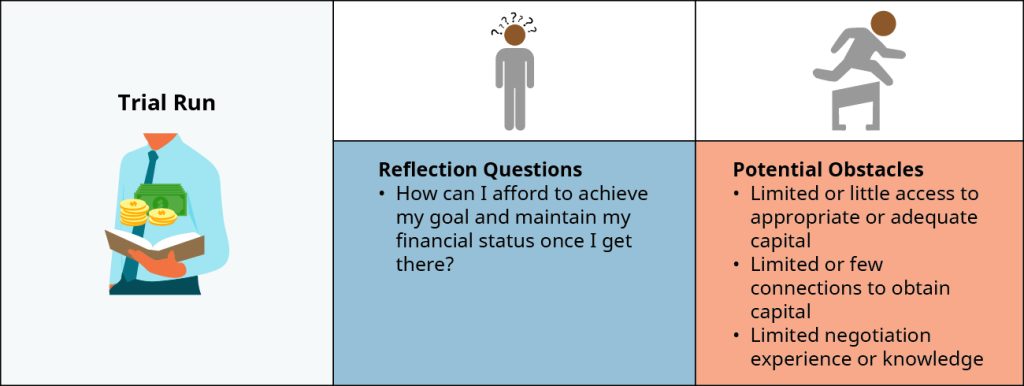
Step 5: Business Plan
The ability to travel and visit new locations is a privilege and a great opportunity to gain exposure to new experiences and opportunities. In addition to the work involved in preparing for a trip, the act and process of traveling involves constant decision making to achieve your desired goals and outcomes. For instance, should you travel to one location in Glacier National Park and explore that area in depth? Or should you attempt to visit as many areas of the park as possible with your given resources and abilities?
The challenge at this step of your entrepreneurial journey is to remain focused on managing your resources to meet your goals and outcomes as you write your business plan for your new venture. You will need to focus on the skills, experience, and resources necessary for your venture, and the management and decision making required to ensure success and adjust your plan based on changes and new information. Just as you might find a location in Glacier National Park where you want to stay for a couple of nights, a deviation from your original business plan (discussed in Business Model and Plan) will also require adjustments and changes based on new information and insights.
Be honest with yourself by running a reality check about your ability to manage a venture, especially from a personal-capacity perspective. For example, if you start a business, will it be a part-time or full-time venture? Will you start while in school? Or will you wait until after graduation? The timing of opening the venture can be the difference between success and failure. Consider the difference between hiking in Glacier National Park in the middle of winter, when the daytime temperature is thirteen degrees below zero, and hiking in the middle of summer, when the daytime temperature is seventy-nine degrees. The timing of your visit to the park is an important part of your enjoyment and success in reaching your destination. In planning for your trip, you would pay attention to your departure time to ensure enjoyment and success in your adventure. Similarly, as part of your business plan, you would also research the best time to open your venture.
Finally, during your travels, getting lost, overwhelmed, or sidetracked is always possible. If you get lost when traveling, you might refer to social navigation apps such as Google Maps, Waze, or HERE WeGo, to find turn-by-turn directions and information. Or you might refer to a weblink, a printed map, or a local expert or guide familiar with the area. The business plan is your map. You should identify decision points and milestones, significant key accomplishments, in your plan. Milestones could include points such as hitting your breakeven point, the point at which income from operations results in exactly enough revenue to cover costs. If the financial projections in your business plan are unattainable, what is your next move within the plan? If you don’t reach the milestones identified in your business plan, what alternative choices can you make to redirect your venture? The business plan, in its first draft, should inform you whether your venture has a chance at success. If there are negative areas, what can you change? Building this plan before starting the business provides you with knowledge and insights about your idea. Make any necessary changes to the plan to strengthen the possibility of success. Then when you open the venture, track whether the reality of the venture aligns with your business plan’s projections and expectations. The business plan functions as both a road map to help you see where you are going next in building your venture and as a checklist to track whether you are on course or need to make adjustments. When entrepreneurs get off track, they can check out self-help websites, speak with a business coach or counselor, or contact local agencies or organizations, including those affiliated with the federal SBA. Organizations that offer free (or low-cost) small business counseling, mentoring, and training, include:
- SCORE (Service Corps of Retired Executives)
- Small Business Development Center (SBDC)
- Women’s Business Center (WBC)
- US Export Assistance Center
- Veterans Business Outreach Center (VBOC)
- Other organizations include locally organized support such as pop-up entrepreneurial schools like PopUp Business School.
These and other resources will be discussed in more depth in Building Networks and Foundations. Look at the review questions and the discussion questions at the end of this section to prepare for creating your business plan.
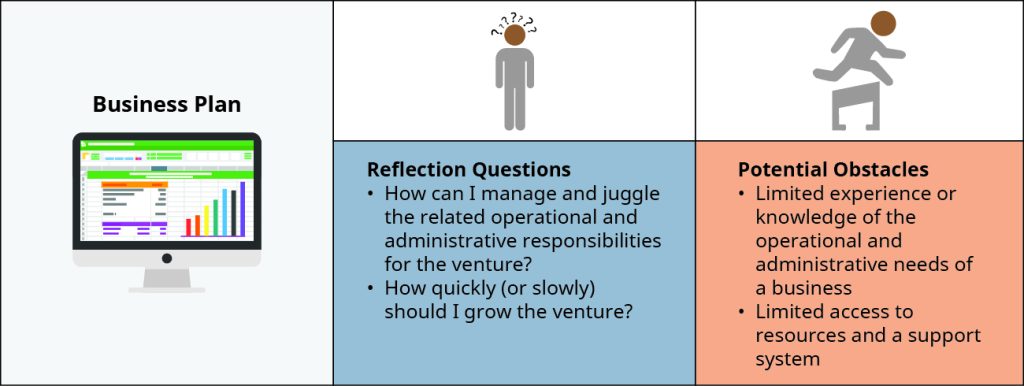
Step 6: Navigation
Once you’ve completed your trip, reflect on the experiences you had. No matter how well you feel you have planned, there is no way you can prepare for all of the potential challenges, changes, and obstacles that may occur: missed or changed flights, poor weather, an unexpected illness, a trail or road closed for repairs, or sudden good fortune. What parts of the trip went well? If you ran into a problem, how did you handle it? Was the problem something you could have anticipated and planned for? Or was it unexpected? What did you learn from the experience? If you were planning a trip to another national park, what would you do differently in your planning stage? Just as seasoned travelers adjust to their circumstances and learn from their experiences, so should you, as an entrepreneur, learn to adjust by meeting and managing challenges head on.
After completing your business plan, you will probably need to adjust your plan (Figure 2.11). You might decide that you will not have enough resources to survive the time until your venture reaches the breakeven point, or you might determine that the location you selected is no longer available. There are multiple variables that require further exploration and research.
By nurturing an entrepreneurial mindset, you will be better prepared when opportunities, challenges, or obstacles surface. Although you won’t be able to predict or plan for every potential scenario along the entrepreneurial journey, an entrepreneurial mindset helps you to be resourceful when opportunities, challenges, or disappointments occur. By unpacking, or by taking an inventory of your available resources, you can also get a better picture of what you may need to unload, retain, or discard, or even if a new direction is the best course of action. On your entrepreneurial journey, evaluating the experience or situation is a perfect opportunity for you to determine how realistic, overambitious, or shortsighted your dreams and goals for your venture may be. This chapter will explore your vision for your future and your venture. Does your vision include a level of flexibility when you discover new information that supports exploring a new area?
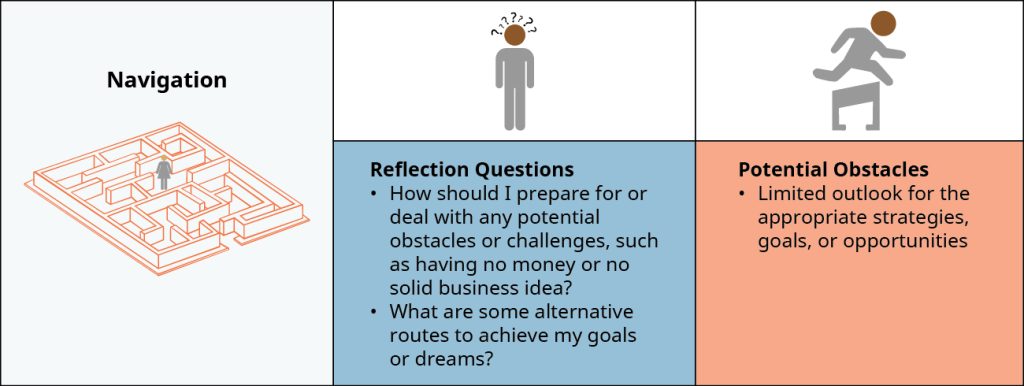
Step 7: Launch
The actual launch is the exciting event when you open your business. By this point, you have made improvements to your product through feedback received in your trial run; you’ve identified the value or benefits provided by your product; you’ve identified your target market; and you’ve identified the location of your launch, whether it is a geographical location or an Internet location.
Inc. magazine provides an analysis of the best locations to launch a new venture, with Austin, Texas, taking the lead (see “Surge Cities: These Are the 50 Best Places in America for Starting a Business,” in Suggested Resources). Consider your target market and the resources necessary to support your venture when choosing the location for your launch. Advice from within the entrepreneurial world suggests that sometimes the launch should take place “under the radar,” meaning in a location where you can make mistakes, fine-tune your business model and offerings, and even become successful without competitors noticing that you have created a disruption within the industry.
Even as you are launching your venture, many variables will require your attention, just as we covered in Step 7. Navigating through these variables as your venture grows requires constant attention as new potential opportunities arise.
Entrepreneur In Action
Sixto Cancel and Think of Us
Sixto Cancel successfully faced the harsh challenges of aging out of the foster-care system without adult support or guidance. He imagined a better foster-care system for young people then cofounded the firm Think of Us. Think of Us is a platform that helps young people in foster care build their own personalized digital advisory board of supportive adults who act as a virtual life-coaching group. The adults guide the young people through the foster-care system and ensure that they are able to become independent when they leave the system at age eighteen. For more information about this venture, visit www.thinkof-us.org.
- David Pridham. “Entrepreneurs: Here’s Good News for 2018.” Forbes. 2018. https://www.forbes.com/sites/davidpridham/2018/01/10/entrepreneurs-heres-good-news-for-2018/#660f5ebd6659 ↵
- UpWork and Freelancers Union. “Freelancers Predicted to Become the U.S. Workforce Majority within a Decade, with Nearly 50% of Millennial Workers Already Freelancing, annual ‘Freelancing in America’ Study Finds.” UpWork. October 17, 2017. https://www.upwork.com/press/2017/10/17/freelancing-in-america-2017/ ↵
- UpWork. “Sixth Annual ‘Freelancing in America’ Study Finds That More People Than Ever See Freelancing as a Long-Term Career Path.” UpWork. October 3, 2019. https://www.upwork.com/press/2019/10/03/freelancing-in-america-2019/ ↵
- David Pridham. “Entrepreneurs: Here’s Good News for 2018.” Forbes. 2018. https://www.forbes.com/sites/davidpridham/2018/01/10/entrepreneurs-heres-good-news-for-2018/#660f5ebd6659; Lawrence F. Katz and Alan B. Krueger. “The Rise and Nature of Alternative Work Arrangements in the United States, 1995–2015.” 2016. https://scholar.harvard.edu/files/katz_krueger_cws_final_nov2018.pdf. ↵
- Elka Torpey and Brian Roberts. “Small-Business Options: Occupational Outlook for Self-Employed Workers.” US Bureau of Labor Statistics. May 2018. https://www.bls.gov/careeroutlook/2018/article/self-employment.htm ↵
- Carly Moulton and Dave Cosgrave. “Second Annual Self-Employment Report.” FreshBooks. 2017. https://www.freshbooks.com/wp-content/uploads/2018/04/2018selfemploymentreport.pdf ↵
- OECD Data. “Self-employment Rate.” OECD.org. n.d. https://data.oecd.org/emp/self-employment-rate.htm. ↵
- Arnobio Molrelix. “The Biggest Reason the U.S. Needs Small Businesses to Thrive Has Nothing to Do with Taxes or the Economy.” Inc., Dec. 20, 2018. https://www.inc.com/arnobio-morelix/inc-entrepreneurship-index-2018-q3.html ↵
- David Jolley. “America Needs Immigrant Entrepreneurs.” Business Insider. September 5, 2017. https://www.businessinsider.com/america-needs-immigrant-entrepreneurs-2017-9 ↵
- Dinah Wisenberg Brin. “Immigrants Form 25% of New U.S. Businesses, Driving Entrepreneurship in ‘Gateway’ States.” Forbes. July 31, 2018. https://www.forbes.com/sites/dinahwisenberg/2018/07/31/immigrant-entrepreneurs-form-25-of-new-u-s-business-researchers/#10ee8099713b ↵
- “Ease of Doing Business Rankings.” Doing Business. May 2019. http://www.doingbusiness.org/en/rankings ↵
- Niels Bosma and Donna Kelley. “Global Entrepreneurship Monitor 2018/2019 Global Report.” GEM Consortium. January 21, 2019. https://www.gemconsortium.org/report/50213 ↵
- Gary Stockton. “Statistics and Obstacles Facing Women Entrepreneurs.” Experian. January 29, 2018. http://www.experian.com/blogs/small-business-matters/2018/01/29/statistics-and-obstacles-facing-women-entrepreneurs/ ↵

